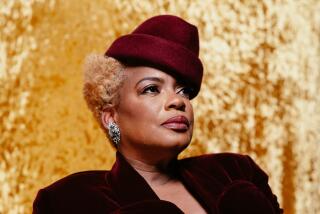‘Native Son’ screenwriter Suzan-Lori Parks on adapting Richard Wright’s novel for 2019
In 1940, Richard Wright published the social protest novel “Native Son,” about one man’s doomed attempts to rise above the racist structures that bind him.
Wright’s protagonist is Bigger Thomas, a 20-year-old black man living on the South Side of Chicago, who, despite his best efforts, falls victim to a system that was set up to ensure his failure.
Though the book would go on to become a best-seller, reviews were split. The power of the story depends upon the readers’ recognition of Bigger’s precarious position in society, and his actions can come across as one-dimensional. In 1949, up-and-coming writer James Baldwin, a former protege of Wright’s, wrote a controversial essay critiquing the story for perpetuating the very stereotypes it sought to destroy.
Almost 80 years after the book was first released, visual artist Rashid Jones and playwright Suzan-Lori Parks, a former student of Baldwin’s, are bringing the third onscreen iteration of Wright’s story to HBO with a film that premieres Saturday. The two film adaptations attempted in the past, a 1951 feature starring the then-45-year-old Wright and a 1986 version featuring Oprah Winfrey, Ving Rhames and Matt Dillon, were critically and commercially panned.
(Warning: Spoilers follow for anyone unfamiliar with the novel.)
The updated “Native Son” stars Ashton Sanders as Bigger, a bike messenger who lands a plush gig as a driver for the wealthy Dalton family. After befriending the Daltons’ well-meaning but privileged daughter Mary (Margaret Qually), he sets off a chain of events that ultimately result in his ruin.
With permission from Wright’s literary estate, Parks crafted a script that diverges largely from the original story line. Not only is the story brought into the 21st century, both Bigger and Mary are more fleshed out, the latter character expanding from merely a plot point into a fully realized character.
“That was something I cared very deeply about in this version,” says Parks. “Traditionally, Mary has been introduced on maybe page 10 or 12 and by page 45, she’s dead. By recognizing Mary’s humanity, we are also encouraged to recognize Big’s. By recognizing the humanity of one you might call the ‘Other,’ you actually achieve your true greatness, which is a full flowering of your compassion.”
The Times caught up with Parks to discuss why Wright’s story is still so enduring today, the challenges of adapting a classic novel and other black works that are overdue for a silver screen adaptation.
Why is now the right time to bring “Native Son” to screens?
I think one of the things that’s been really cool to look at is how far we’ve come...and how far maybe we haven’t come. How free we are — as a people, as a civilization — and how free we are not.
What were some of the biggest challenges in adapting Wright’s novel into a screenplay?
We wanted to make it relevant to 2019. So basic things, like a coal furnace in a house in 2019 — I had to find a way to make that make some kind of sense because most houses don’t have that kind of heating system anymore. So they’ve got a coal furnace. OK, why do they have a coal furnace? It’s because Mr. Dalton, he’s progressive, but he likes things in the old style. He’s a Luddite; he doesn’t like too many cameras all around his house. So that helps us too, because then Big can have his alibi work for a hot minute; it’s plausible.
And also on a deeper storytelling level, you have the Daltons who are progressive — they’re good people. And yet, they live in a house that’s behind the times. And so that’s a dichotomy in their character makeup. That we’re moving forward and yet we’re still somehow moving in structures, systems and systemic patterns that are holdovers from an older time. All of us, not just the Daltons. So it kind of works on that level too.
Had you seen the two previous adaptations?
I had. I looked at them once I got the job. Not because I needed to figure What am I going to do? — because obviously those answers were in the novel, but I just thought, Well, let me at least be conscious of the efforts that have come before.
How is this film different from those two previous attempts?
I didn’t study them, so they’re not at the forefront of my mind. I’m not a scholar of cinema. But I think they both included the murder of Bessie. I think they followed the novel more closely. I don’t think they dared to attempt a friendship between Big and Mary, which we dared to do in this, what people a few years ago might call, this ‘post-racial society.’ The idea that Big, Mary, Jan and Bessie might all become friends, we dared to see how that played out. I think they included the trial, which is at the end of the book. We chose not to. We really wanted to spend our time with Big and Mary and their developing friendship so we spent our time on the front end not on the back end.
Why do you think it has taken so long for this story to be adapted for contemporary times?
There are so many great novels that haven’t yet been adapted. I mean, [Wright’s] ‘Black Boy’ has not been adapted. I have a bookshelf of books that haven’t been adapted.
Speaking of, what other classic black works would you like to see adapted?
Oh, geez. All of them. Let’s see. [Jean] Toomer’s “Cane.” Baldwin’s “Another Country,” “Amen Corner,” “Giovanni’s Room.” I mean, you could just go down the list. All of Toni Morrison, all of Alice Walker. We could put all of August Wilson’s plays on the screen.
REVIEW: Suzan-Lori Parks’ ‘Father Comes Home From the Wars’ is an entrancingly intimate drama »
I did Zora Neale Hurston’s “Their Eyes Were Watching God” for Oprah, but [Hurston’s] “The Sanctified Church” or “Mules and Men” might make a cool movie. And what’s cool is there are so many platforms out there now, so there are a lot of places for these works. The list is long and the work is of high quality, so maybe those things can start happening again.
Why do you think Wright’s novel is still relevant today?
I know that it still speaks of the difficulty of not only life in America, not only life for people of African descent, but life [in general]. The notion that someone can work hard and struggle and try to do things right, try to do things correctly, try to play by the rules, and still fall through the cracks. And really, in a way, that says less about the person and more about the system, more about the cracks.
In this country, often we might see someone in difficult circumstances and we might point our fingers at them. And yet we forget that we actually perpetuate and live in a culture that encourages when someone falls through the cracks, we blame that someone as if their failure is specific to them. And yet we rarely look at the system and we rarely want to believe that we are perpetuating the system that is just creating more cracks.
‘Native Son’
Where: HBO
When: 10 p.m. Saturday
Rating: TV-MA (may be unsuitable for children under the age of 17)
follow me on twitter @sonaiyak
More to Read
Only good movies
Get the Indie Focus newsletter, Mark Olsen's weekly guide to the world of cinema.
You may occasionally receive promotional content from the Los Angeles Times.











